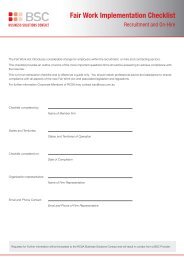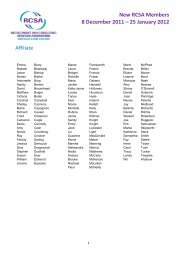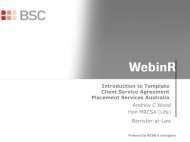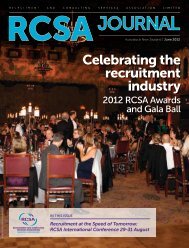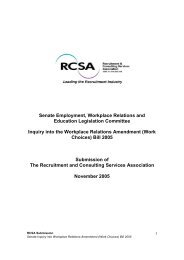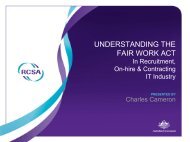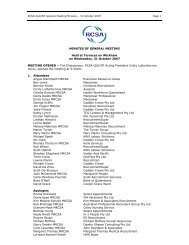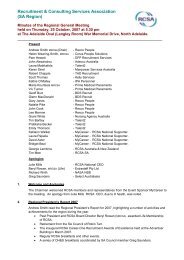Unfair Dismissal - RCSA
Unfair Dismissal - RCSA
Unfair Dismissal - RCSA
You also want an ePaper? Increase the reach of your titles
YUMPU automatically turns print PDFs into web optimized ePapers that Google loves.
Head count test (applies to dismissals that occur on or after 1 January 2011)<br />
The head count involves counting all employees employed by the employer at the time of<br />
dismissal or notice of dismissal (whichever is the earliest). Casual employees are not to be<br />
included in the count unless they have been employed by the employer on a regular and<br />
systematic basis.<br />
In both tests, employees of associated entities are also counted.<br />
How is a period of employment defined?<br />
An employee’s period of employment is based on the employee’s continuous service with<br />
the employer.<br />
Service as a casual employee can count towards the period of employment as long as it was<br />
on a regular and systematic basis and the employee had a reasonable expectation of<br />
continuing work on a regular and systematic basis (Section 384).<br />
Any unauthorised absences and most periods of unpaid leave do not count as service;<br />
however these do not break an employee’s continuity of service (Section 22).<br />
Example of how continuity of service is calculated where there are periods of unpaid leave<br />
John worked for 6 months as a full‐time permanent employee. He then took leave without<br />
pay for 2 months and returned to work for a further 6 months. John’s total period of<br />
continuous service is 12 months, which is the total period worked before and after the<br />
period of leave without pay.<br />
How is the minimum employment period assessed?<br />
Whether an employee has served the minimum employment period is assessed either when<br />
the person is given notice of dismissal, or when the dismissal actually takes effect, whichever<br />
happens first (Section 383).<br />
What happens to the period of employment when the business is transferred to a new<br />
owner?<br />
In a transfer of business, a new employer can choose not to recognise the employee’s<br />
service under the old employer for the purposes of unfair dismissal provisions. However,<br />
they must inform the employee in writing before the new employment starts.<br />
Associated (related) entities (Section 384).<br />
This does not apply if the transfer of business was between associated entities. In this<br />
circumstance service with the first employer will always count towards service with the<br />
second employer for the purposes of unfair dismissal provisions.<br />
What has changed?<br />
Workplace Relations Act 1996 Fair Work Act 2009<br />
Employees excluded from making an unfair<br />
dismissal claim if at the time of dismissal<br />
they were employed by a business with 100<br />
or fewer employees.<br />
No exclusions for unfair dismissal provisions<br />
based on business size. Employees have to<br />
serve minimum employment periods before<br />
they can make an unfair dismissal claim.<br />
4



